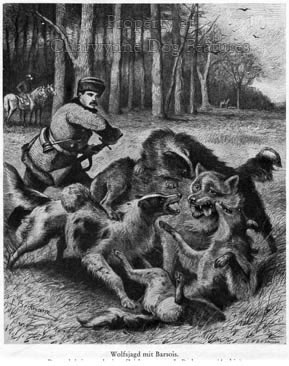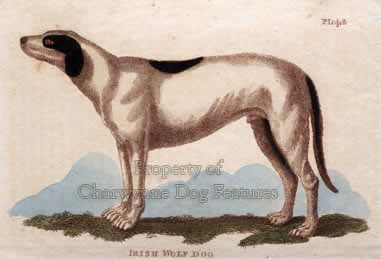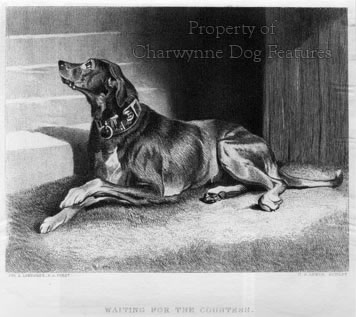90 KEEPING THE WOLF FROM THE DOOR
KEEPING THE WOLF FROM THE DOOR
by David Hancock
 "This Dog hath so himself Subdu'd
"This Dog hath so himself Subdu'd
That Hunger cannot make him rude,
And his behaviour doth confess
True Courage dwells with Gentleness.
With sternest Wolves he does engage
And acts on them successful rage."
These words of Katherine Philips, written in 1664 on the Irish Greyhound, forerunner of the Irish Wolfhound, convey the timeless admiration for the noble nature of a huge brave hound, ferocious in the chase but gentle in repose. And a wolfhound had to produce a 'successful rage' to engage a wolf, a powerful potentially savage predator well able to defend itself and capable of weighing a hundredweight. Wherever wolves were found and livestock had to be protected, the big shepherd dogs like the shepherd's mastiff here and the German, Dutch and Belgian varieties or the even bigger flock guardians, such as the Anatolian, the Pyrenean, the Tatra and Estrela Mountain Dogs and the Maremma, were utilised. Whenever an offensive had to be mounted however, faster but similar-sized hounds were used, with the Russian wolfhounds inspiring Turgenev and Tolstoi by their heroic endeavours.
Although the Russian wolfhound is known to kennel clubs around the world as the Borzoi, the word itself means light, swift and agile, being used rather loosely just as greyhound was in Britain, levrier in France and windhund in Germany. The Borzoi was more commonly used for fox and hare coursing and the Russians once referred to Asiatic, Polish (Chart or Chort), Crimean or Tartar Borzoi (these more like Salukis) and the Circassian variety too. The Scottish Greyhound (Deerhound) was used on wolves and other quarry, coursing hounds having long been used in a wide variety of pursuits. It is easy to forget when looking at contemporary breeds that their ancestors did not breed true to type, being judged solely on performance, not on conformation to a set standard. Behind the modern single breed of Russian Borzoi, there are barrel-chested Caucasian Borzoi, huge curly-haired Courtland Borzoi and bigger-boned Crimean dogs. This type was found as far west as Albania too.
The graceful athletic build of the Russian wolfhound has long drawn widespread admiration: Charles Darwin described them as an 'embodiment of symmetry and beauty'. Undoubtedly the attractive silky coat of the modern pedigree Borzoi enhances its physical appearance. But as with the Saluki and the Ibizan hound, of this type of swift hound, there were varieties of coat in the Borzoi too. The Hunter's Calendar and Reference Book, published in Moscow in 1892, divided the Borzoi into four groups. First, Russian or Psovoy Borzoi, more or less long-coated; second, Asiatic, with pendant ears; third, Hortoy, smooth-coated and fourth, the Brudastoy, stiff-coated or wire-haired. But whether the hounds were sleek or bristle-haired, wolf coursing in Russia before the Revolution was what fox-hunting was to Britain and par force hunting was to France.
As Leo Tolstoi recorded in War and Peace: "Fifty-four coursing hounds were taken with six mounted horsemen and keepers of hounds. Apart from the Master and his guests, another eight huntsmen took part, with more than forty hounds. In the end, there were one hundred and thirty hounds and twenty horsemen in the field." Tsar Peter II kept a pack consisting of 200 coursing hounds and over 420 Greyhounds. Prince Somzonov of Smolensk had 1,000 hounds at his hunting box, calling himself Russia's Prime Huntsman. Better known was the hunt with the Perchino hounds near Tula on the river Upa, where Archduke Nicolai Nikolsevich established a hunting box in 1887 and hunted two packs of 120 par force hounds, 120 to 150 Borzoi and 15 English Greyhounds. To ensure sufficient hardiness for winter wolf hunts, both horses and hounds were kept in unheated stables or kennels.
Usually 20 leashes of Borzois were taken to a hunt, each consisting of two males and a bitch. The hunting season was summer coursing (June to early August) on hare or fox, then summer training for Borzois in August. This consisted of 20 kilometres walking or trotting with the hunt horses, followed by advanced training on captive wolves in early September, then the wolf-coursing season from mid-September to the end of October. Hunting from sledges sometimes took place from October, with mounted beaters putting up the wolves, which were often fed to keep them in the hunting grounds. In the Perchino game reserve, between 1887 and 1913, 681 wolves were killed, as well as 743 foxes, 4,630 brown hares and 4,026 white hares; Borzois obtaining the bulk of this bag.
Whatever the rights and wrongs of hunting on such a scale, the robustness, fitness and stamina of the hounds must have been remarkable. Coursing with Borzois in Tsarist Russia called for a high standard of horsemanship and superbly-trained hounds. Each mounted handler rode with his three hounds on long leashes, slipping the hounds whenever a wolf was either put up by the extended line of mounted beaters or flushed out of the woods by scent hounds of the Gontchaja type. Many of us would find it difficult enough to control three Borzois on short leashes whilst dismounted! The Borzoi is still important for the Russian fur trade, for they catch foxes without mauling them and ruining their pelts. This also avoids the crueller use of iron spring traps.
Huge shaggy-coated hunting dogs were used by the Celts in their central European homeland in the eight century BC and these accompanied them on their migrations to Britain, Ireland and Northern Spain from the fifth to the first century BC. In his Gentleman's Recreation of 1675, Nicholas Cox wrote: "Although we have no wolves in England at the present, yet it is certain that heretofore we had routs of them, as they have to this very day in Ireland; and in that country are bred a race of greyhounds which are commonly called wolfdogs, which are strong, fleet and bear a natural enmity to the wolf. Now in these greyhounds of that nation there is an incredible force and boldness..."
Behind the Irish Wolfhound there are at least three distinct types: Just over one hundred years ago, Fitzinger identified "...The Irish Greyhound, next to the Indian and Russian Greyhound, is the largest specimen of the greyhound type, combining the speed of the Greyhound with the size of the Mastiff. The second type is the Irish coursing dog, a cross between the Irish Greyhound and the Mastiff or bandogge. He is shorter in the neck, with a coarser skull, broader chest and heavily flewed lips. " The third variety he described as a cross between the Irish Greyhound and the shepherd dog, being low on the leg and having a shaggy coat. The latter sounds like a shepherd's mastiff or native flock guardian, a bigger version of the Irish Beardie or hirsel.
Lord Altamont wrote to the Linnaean Society in 1800 to state that: "There were formerly in Ireland two kinds of wolfdogs - the greyhound and the mastiff. Till within these two years I was possessed of both kinds, perfectly distinct, and easily known from each other. The heads were not so sharp in the latter as the former; but there seemed a great similarity in temper and disposition, both being harmless and indolent." He stated that the painting held by the Society was of the mastiff wolfdog; it was 28 inches at the shoulder.
The Countess of Blessington in Ireland was presented with a giant Suliot Dog by the King of Naples. Lady Blessington was one of the Powers of Kilfane, who at one time were the only people who patronised the Irish Wolfhound. Suliot Dogs came from Epirus in Greece, location of the Molossian people, and were giant hounds, used as outpost sentries in the Austrian Army and as 'parade dogs' or mascots of German regiments. They were used to give added stature to German boarhounds (the hunting dogs being nearer to 26 inches at the shoulder than the 30 inches minimum of today's Great Danes). Lady Blessington's Suliot Dog is likely to have been used as a sire at Kilfane.
The Irish Wolfhound was all but lost to us in the latter half of the 19th century. Then, in 1863, an Englishman, Captain George Augustus Graham, a Deerhound breeder, noted that some of his stock threw back to the larger type of Irish Wolfhound. He obtained dogs of the Kilfane and Ballytobin strains, the only suitable blood available in Ireland at that time. He then interbred these with Glengarry Deerhounds, which had Irish Wolfhound blood in their own ancestry. In due course he produced and then stabilised the type of Irish Wolfhound which he believed to be historically correct. Out-crossing continued, with Capt Graham using the blood of a 'great dog of Tibet', then, between 1885 and 1900, seven Great Dane crosses were conducted, and Borzoi blood used several times in the 1890s. This is of course how all hunting dogs were once bred, good dog to good dog, irrespective of breed titles. Closed gene pools are a modern phenomenon.
The Indian wolf has been hunted using similarly shaggy-coated hounds, like the Banjara or Vanjari, 28 inches high and grey mottled, and the 30 inch Rampur Hound, the smoother-coated Shikari dog of Kumaon, the Great Dane-like Sindh Hound, the beautiful ivory-coated Rajapalayam and the Dobermann-shaped Patti of Tamilnad. Such types disappear when the threat from wolves recedes but their value to man was considerable. Our contemporary affection for the wolf would not have been shared by those living in remote villages in India or a number of European countries in the middle ages. Wolves, operating in packs, threatened livestock and sought human prey when desperate for food. Powerful dogs of the flock guarding type were needed to protect livestock and strong-headed very fast hounds were needed to course them. Hunting wolves for sport may not appeal to 21st century sympathies, but that should not lessen our admiration for wolfhounds, their bravery and athleticism in the hunt, when wolf numbers required checking.
In medieval times, there were laws under which some court fines were assessed in terms of wolves' tongues. At one time, the yearly tax in Wales was established at 300 wolves' heads. France was one country particularly populated by wolves; as early as 1467, Louis XI created a special wolf-hunting office, whose top member was appointed from the highest families in the land. In the French province of Gevaudan in the 1760s one wolf is alleged to have killed more than fifty people, the majority women and children. At the end of the French revolution in 1797, 40 people were killed by wolves, tens of thousands of sheep, goats and horses slaughtered by them, and, in some remote districts not a single watchdog left alive. The dense forests led to the French mainly hunting them with packs of scenthounds rather than coursing them with faster hounds.
Against that background, it is surely important for us to respect past function, which bequeathed us the wolfhound breeds, and breed to reflect that heritage. Borzois bred purely for beauty of form and Irish Wolfhounds bred mainly for shoulder height shows little respect for their distinguished past service to man and little regard for historical honesty. It is sad to read, in show critiques on Irish Wolfhounds, such judges's comments as these: "I was very shocked at the terrible soft condition of some of the hounds..." "Movement should be a cause for concern, both for breeders and owners...Many hounds lacked strength and muscle particularly in hindquarters..." "...the most prevalent fault in the entry was deviation from true in front action." (And why do Irish Wolfhounds need legs like tree-trunks when Russian ones do not?)
But in Borzois too the critiques are worrying: "The effortless power on the move seems to have disappeared..." with another mentioning "too much emphasis being placed on copious amounts of coat..." When hounds are bred without regard for their physical soundness and the coat becomes more important than the essential wolfhound anatomy, we are heading for the destruction of such remarkable breeds in the immediate future. Huge dogs need soundness of physique most of all; their ability to lead a fulfilling life is prejudiced when their anatomy itself is a handicap. Breeders and owners who rate the coat above structural soundness reveal at once their disrespect for their own breed. Wolfhounds are extraordinary hounds; their past courage and athleticism deserves our respect. They were never intended to be ornaments or fashion accessories; they survived because they were superlative hunting dogs, and could still be.